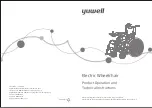
D200, D200 30°
2022-11
Before use
5
EN
NL
2.4 Transport
2.4.1 Transport by vehicle, as luggage (D200, D200 30°)
Risk of injuries
Make sure that the wheelchair is attached properly to avoid injury from the passengers during
collision or sudden braking.
NEVER use the same seatbelt to secure the wheelchair and passenger.
1. Remove footrests, armrests and accessories.
2. Store footrests, armrests and accessories safely.
3. If possible, fold the wheelchair and remove the rear wheels.
4. Place the wheelchair in the luggage compartment.
5. If the luggage and passenger compartments are NOT separated, attach the frame of the
wheelchair securely to the vehicle. You can use the available safety belts in the vehicle.
2.4.2 Use of the wheelchair as seat in a motor vehicle (only D200 without B69)
Risk of injuries
For D200 30° and D200 with B69: Do NOT use your wheelchair as a seat in a
vehicle, see the following symbol.
The wheelchair has passed the crash test of ISO 7176-19: 2008 and, as such, has
been designed and tested for use only as forward-facing seat in a motor vehicle.
The wheelchair's pelvic belt alone is not suited as an occupant restraint belt.
The wheelchair is tested using the four-point strap-tie system and a 3-point occupant-restraint
system.
Whenever feasible, use the seat of the vehicle and store the wheelchair in the cargo area.
Steps to secure the wheelchair in a motor vehicle:
1. Check that the vehicle is equipped with a suitable wheelchair tie down and occupant-
restraint system, conform ISO 10542.
2. Check that the components of the wheelchair tie down and occupant restraint system are
not frayed, contaminated, damaged or broken.
3. If equipped with an adjustable seat and/or back tilt, make sure that the wheelchair user is
sitting as upright as possible. If the user's condition prevents this, a risk assessment should
be done to evaluate the user's safety during transit.
4. Remove all mounted accessories such as trays and respiratory equipment, and secure
them in a safe place.
5. Position the wheelchair facing forward in the travelling direction, centrally between the tie-
down rails mounted in the floor of the vehicle.
6. Make sure that the indicated zones around the wheelchair user are clear from rigid vehicle
parts.
WARNING
WARNING
Figure 1
Figure 2


































![Dietz Rehab AS[01] User Manual preview](http://thumbs.mh-extra.com/thumbs/dietz-rehab/as-01/as-01_user-manual_2495939-01.webp)







